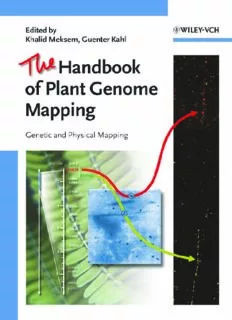
The Handbook of Plant Genome Mapping: Genetic and Physical Mapping (v. 1) PDF
Preview The Handbook of Plant Genome Mapping: Genetic and Physical Mapping (v. 1)
The Handbook of Plant Genome Mapping Edited by Khalid Meksem and G(cid:1)nter Kahl Further Titles of Interest G(cid:1)nterKahl The Dictionary of Gene Technology Genomics, Transcriptomics, Proteomics 2004 ISBN3-527-30765-6 ChristophW.Sensen Essentials of Genomics and Bioinformatics 2002 ISBN3-527-30541-6 MichaelR.BarnesandIanC.Gray(Editors) Bioinformatics for Geneticists 2003 ISBN0470-84393-4 The Handbook of Plant Genome Mapping Genetic and Physical Mapping Edited by Khalid Meksem and G(cid:1)nter Kahl Editedby Thisbookwascarefullyproduced.Nevertheless, authors,editorandpublisherdonotwarrantthe Prof.Dr.KhalidMeksem informationcontainedthereintobefreeoferrors. Dept.Plant,Soil,Agriculture Readersareadvisedtokeepinmindthatstate- SouthernIllinoisUniversity ments,data,illustrations,proceduraldetailsor Carbondale,IL629 otheritemsmayinadvertentlybeinaccurate. USA Prof.Dr.G(cid:1)nterKahl LibraryofCongressCardNo.:appliedfor PlantMolecularBiology BiocentreandGenXPro BritishLibraryCataloguing-in-PublicationData: JohannWolfgangGoetheUniversity Acataloguerecordforthisbookisavailable Marie-Curie-Strasse9 fromtheBritishLibrary. 60439FrankfurtamMain Germany Bibliographicinformationpublishedby DieDeutscheBibliothek DieDeutscheBibliothekliststhispublication intheDeutscheNationalbibliografie; detailedbibliographicdataisavailableinthe Internetat<http://dnb.ddb.de>. CoverIllustration: TheTitlePageshows(fromlefttoright)alinkage c2005WILEY-VCHVerlagGmbH&Co.KGaA, group(arrow-headed)fromageneticmap,ablow- Weinheim upofaspecificregion(inblue),thepositionsof molecularmarkers(RFLPs)alongthisregion, Allrightsreserved(includingthoseoftranslation (whichisscaledincentiMorgans,cMs),andthe intootherlanguages).Nopartofthisbookmaybe twoneighboringRFLPmarkersS10620(red)and reproducedinanyform–byphotoprinting,mi- S14162(green)atposition1.0cM.Thesetwo crofilm,oranyothermeans–nortransmittedor RFLPsareradioactivelylabelledandhybridizedto translatedintoamachinelanguagewithoutwritten anarrayofBACclonesimmobilizedonanylon permissionfromthepublishers.Registered membraneand(1)usedtoisolategenomicDNA names,trademarks,etc.usedinthisbook,even containingsequencesofinterest(e.g.genes whennotspecificallymarkedassuch,arenottobe flankedbybothmarkers)and(2)localizedon consideredunprotectedbylaw. chromosomalfibresbyfibrefluorescentinsitu hybridization(right).Thistechniqueisavariantof PrintedintheFederalRepublicofGermany. theconventionalfluorescentinsituhybridization Printedonacid-freepaper. (FISH)methodforthedetectionoftargetse- quences,inwhichthetwoBACclonesarelabelled Typesetting hagedornkommunikation, withdifferentfluorochromes,whoseemission Viernheim lightiseitherinthered(S10620)oryellowish- Printing StraussOffsetdruckGmbH,M(cid:2)rlenbach greenrange,respectively(S14162).Thechromo- Bookbinding Litges&DopfBuchbindereiGmbH, somalfibresaregeneratedbymolecularcombing. Heppenheim Fordetails,Chapter6:“PhysicalmappingofPlant Chromosomes”byBarbaraHass-JacobusandScott ISBN-13: 978-3-527-31116-3 A.Jackson ISBN-10: 3-527-31116-5 We dedicate this book to the memory of late Jozef (Jeff) Stefaan Schell, who strongly inspired our way to think and to do research Preface At a time, when more than 150 bacterial and archaebacterial genomes, two plant genomes and a series of avertebrate and vertebrate genomes including the human genome have been deciphered base bybase (some gaps notwithstanding), and more than 400 other genomes are in the mill, a Handbook of Plant Genome Mapping(GeneticandPhysicalMapping)mightseemabitoutoftime.Infact,for manyplantsandanimalsgeneticmapswithvastlydifferentdensitiesareavailable andbeingimprovedcontinuously.Someofthescientificjournalsalreadybeginto discourageauthorstopublishsuchincreasinglydensemapsandaskformorede- tailed informations such as genes isolated by map-based cloning. Inessence,geneticmapsarebynomeansorphanizedanymore.Also,ifnotyet available, genetic maps can be generated with speed and relative ease, provided a good selection of polymorphic parents, a wonderful and numerous segregating progeny, a highly resolving molecular marker system, powerful computer packages,alotofpeopleandenoughmoneyareathand.So,inanot-too-farfuture, genetic maps will be commonplace given the relative ease of their generation. Thesituationisquitedifferentforphysicalmapsofgenomes.Firstofall,aphys- ical map traditionally depends on the availability of a genetic map. Despite other approaches, the most practical method to establish a physical map still requires a large-insert clone bank on one hand, and a preferably highly dense genetic map on the other. And each and every marker, or marker bundle, that allows easyidentificationoftheunderlyingDNAclonesofwhatevermake-up(BACclones seemtohavewontheracebynow,andYACcloneslostbecauseofchimerismand redundancies)iswelcome.Ahighlyresolvingphysicalmap,however,stillrequires alotmoreinputinlabour,time,knowledgeandfundsthanageneticmap.Itisfor this reason, that physical maps are available only for relatively few higher organ- isms,thoughcommonforprokaryota,whosechromosomesaresequencedanddi- rectly aligned into an ultimate physical map. Such complete genomic sequences (i.e. complete physical maps) are still an exception for eukaryotes. And, with one single exception, techniques used for the assembly of whole genome se- quences still makes use of genetic and physical maps. The exception to this rule is the HAPPYmapping procedure, an ingenious tool with which physical maps can directly and happily be generated. This exception aside, the treadmill for many postdocs is and will be for the foreseeable future, the establishment of ge- VIII Preface netic maps of the target organism as a prerequisite, including the production of BAC libraries and the physical alignment of the thousands of clones into contigs, atleast foraregion ofinterest.Andgenetically mapped markerswillstillserve to guide the way. Inappreciation ofthese facts,we setouttoinviteinternationally renownedand highlycompetentplantresearcherswithanundisputedscientificreputationtopor- traytheircontributionstothegeneticandphysicalmappingofplantgenomes.The present “Handbook of Plant Genome Mapping: Genetic Mapping, Physical Map- ping”isthemostcomplete,up-to-dateandcompetentlywrittenandcompiledtrea- tiseof thiscomplextopic. Alltheauthorshave striventoreportthelatestachieve- ments and developments in their fields and did not spare any pains to introduce their areas of research, to detail methodological aspects and to present the state- of-the-art and future perspectives as well. This Handbook reflects the quality of worldwide research on plant genetic and physical mapping. Theeditorsmostcordiallyappreciatethevariouscontributionstomakethisbook a standard for plant genome mapping for the foreseeable future. November 2004 Khalid Meksem G(cid:1)nter Kahl Carbondale (IL, USA) Frankfurt am Main (Germany) Contents Part I Genetic Mapping 1 1 Mapping Populations and Principles of Genetic Mapping 3 Katharina Schneider Overview 3 Abstract 3 1.1 Introduction 4 1.2 Mapping Populations 6 1.2.1 Mapping Populations Suitable for Self-fertilizing Plants 7 1.2.1.1 F Populations 7 2 1.2.1.2 Recombinant Inbred Lines 8 1.2.1.3 Backcross Populations 9 1.2.1.4 Introgression Lines: Exotic Libraries 10 1.2.1.5 Doubled Haploid Lines 11 1.2.2 Mapping Populations for Cross-pollinating Species 12 1.2.3 Two-step Strategies for Mapping Mutants and DNA Fragments 12 1.2.4 Chromosome-specific Tools for Mapping 13 1.2.5 Mapping in Natural Populations/Breeding Pools 14 1.2.6 Mapping Genes and Mutants to Physically Aligned DNA 15 1.2.7 Specific Mapping Problems 15 1.3 Discussion 17 Acknowledgments 18 References 19 2 Molecular Marker Systems for Genetic Mapping 23 Henry T. Nguyen and Xiaolei Wu Abstract 23 2.1 Introduction 23 2.2 DNA-based Markers Popularly Used in Genetic Mapping 25 2.2.1 RFLP 25 2.2.1.1 Conventional RFLPAnalysis 26 2.2.1.2 PCR-RFLP 26 2.2.1.3 Mismatch PCR-RFLP 27
Description: